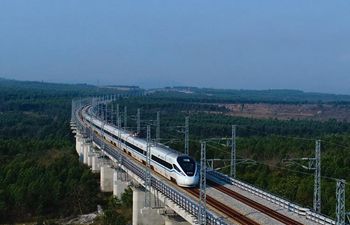LOS ANGELES, March 30 (Xinhua) -- U.S. private spaceflight company SpaceX has completed Friday morning the delivery of 50 communications satellites into orbit for Iridium Communications on the one year anniversary for reusable rockets.
A SpaceX Falcon 9 rocket blasted off from Space Launch Complex 4E (SLC-4E) at Vandenberg Air Force Base in California at 7:13 a.m. PDT, carrying 10 satellites for Iridium Communications, as part of the company's Iridium Next constellation. SpaceX has launched the first four missions, totaling 40 satellites, in 2017.
"Today, this is our fifth launch for the Iridium constellation, using only three rockets," SpaceX materials engineer Michael Hammersley said during live commentary.
The first stage of Falcon 9 for the Iridium-5 mission previously supported the Iridium-3 mission from SLC-4E in October 2017. SpaceX didn't attempt to recover Falcon 9's first stage after Friday's launch.
Friday is exactly one year to the day after SpaceX's first used Falcon 9 rocket launch and landing. Since then, the company has commonly reused Falcon 9 first stages on later missions. It is pursuing fully reusable rockets in an effort to lower the cost of spaceflight.
The satellites began deployment about an hour after launch.
"Due to some restrictions from the National Oceanic and Atmospheric Administration, or NOAA for short, SpaceX will be intentionally ending live video coverage from the second stage just prior to engine shutdown," Hammersley said. He did not elaborate on what those NOAA restrictions might be.
A successful deployment of all 10 satellites was confirmed about one hour and 12 minutes after the liftoff.
"Successful deployment of all 10 @IridiumComm NEXT satellites to low-Earth orbit confirmed," the Hawthorne, California-based company tweeted.
There is also another heightened interest in this launch.
By using "Mr. Steven," a large navigable platform ship with extended "arms" and a net strung between them, SpaceX was trying to "catch" one of the two payload fairings that enclose the satellite at the top of the rocket.
"Attempting recovery of fairing falling down from space (right now) with our boat, Mr Steven. It's a giant steel & webbing catcher's mitt superstructure on a high-speed ocean ship," Elon Musk, CEO of SpaceX, tweeted.
These fairings were separated from the rocket at about three minutes after launch.
The value of these fairings is about six million U.S. dollars, and recovering and reusing them would save money for SpaceX. Currently, a typical Falcon 9 launch costs around 62 million U.S. dollars, according to the company.
"Mr Steven is 5 mins away from being under the falling fairing," Musk tweeted after Friday's launch.
SpaceX's previous attempt to catch a Falcon 9 fairing just missed earlier this year.
Friday's mission, called Iridium-5, is the fifth set of 10 satellites in a series of 75 total satellites that SpaceX will launch for Iridium's next generation global satellite constellation, Iridium NEXT.
When completed, the constellation will consist of 66 operational satellites and nine spares in orbit. SpaceX has launched the first four missions, totaling 40 satellites, in 2017.
The company plans to have a total of 75 satellites launched into orbit by mid-2018.
Iridium is so far the only mobile voice and data satellite communications network that spans the entire globe, including across oceans, airways and polar regions.
According to the company, it is on track to fully replace the world's largest commercial satellite network of low-Earth orbit satellites in what will be one of the largest "tech upgrades" in history.
The satellite communications company has partnered with Thales Alenia Space for the manufacturing, assembling and testing of 81 Iridium NEXT satellites.
Iridium's next-generation global satellite constellation will deploy a cross-linked low-Earth orbit architecture, covering 100 percent of the Earth's surface. The process of replacing the satellites one by one in a constellation of this size and scale has never been completed before.
SpaceX initially aimed to launch the Iridium-5 mission Thursday, but a technical glitch with one of the satellites forced a delay.
Friday's launch is one of two missions in four days for SpaceX. Another used Falcon 9 rocket will launch an uncrewed Dragon cargo ship, which has also flown previously, to deliver cargo to the International Space Station.
The U.S. National Aeronautics and Space Administration (NASA) cargo mission is scheduled to launch on Monday from Cape Canaveral Air Force Station in Florida, with Dragon arriving at the space station next week.
Under an agreement with NASA, SpaceX is now developing the refinements that will enable Dragon to fly crew. Dragon's first manned test flight is expected to take place as early as 2018, according to SpaceX.

















